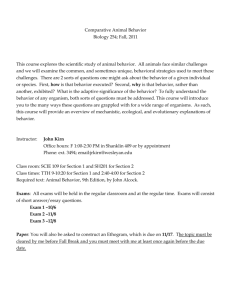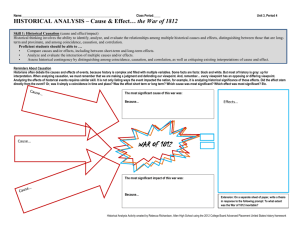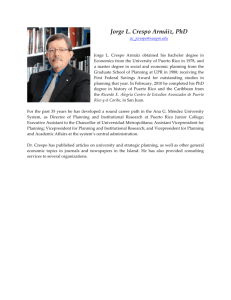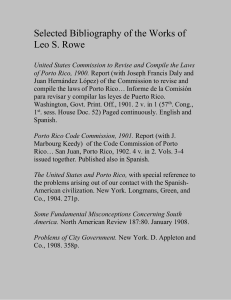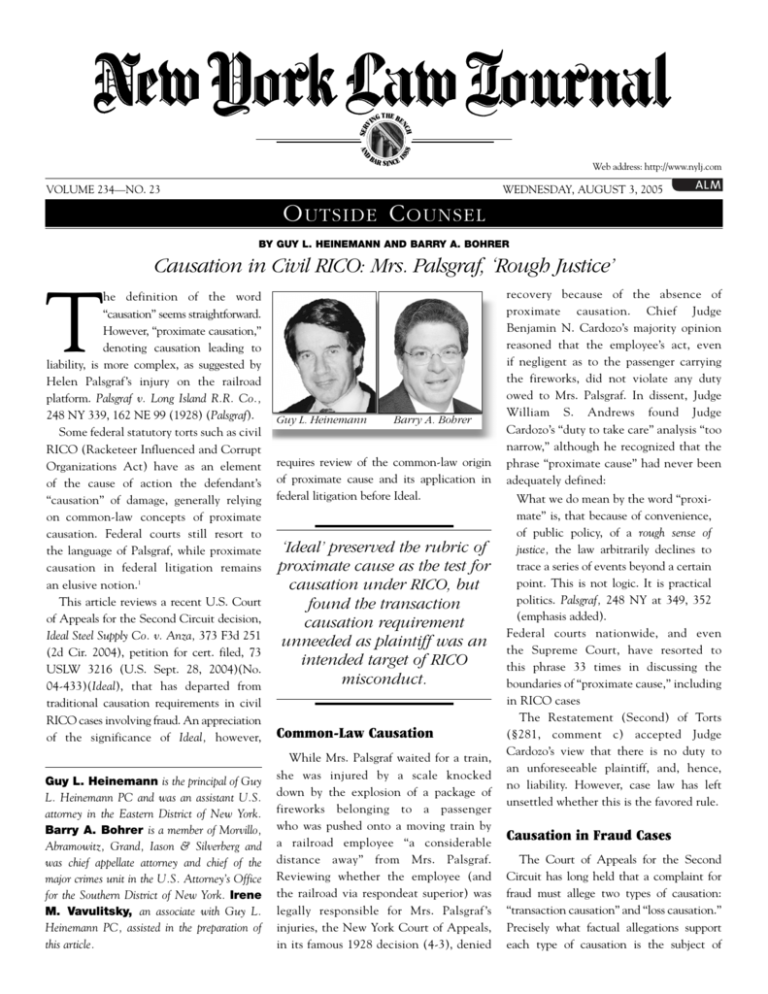
AND
88
8
SER
V
H
NC
THE BE
ING
BA
R SINCE 1
VOLUME 234—NO. 23
Web address: http://www.nylj.com
WEDNESDAY, AUGUST 3, 2005
O UTSIDE C OUNSEL
BY GUY L. HEINEMANN AND BARRY A. BOHRER
Causation in Civil RICO: Mrs. Palsgraf, ‘Rough Justice’
T
he definition of the word
“causation” seems straightforward.
However, “proximate causation,”
denoting causation leading to
liability, is more complex, as suggested by
Helen Palsgraf’s injury on the railroad
platform. Palsgraf v. Long Island R.R. Co.,
248 NY 339, 162 NE 99 (1928) (Palsgraf).
Some federal statutory torts such as civil
RICO (Racketeer Influenced and Corrupt
Organizations Act) have as an element
of the cause of action the defendant’s
“causation” of damage, generally relying
on common-law concepts of proximate
causation. Federal courts still resort to
the language of Palsgraf, while proximate
causation in federal litigation remains
an elusive notion.1
This article reviews a recent U.S. Court
of Appeals for the Second Circuit decision,
Ideal Steel Supply Co. v. Anza, 373 F3d 251
(2d Cir. 2004), petition for cert. filed, 73
USLW 3216 (U.S. Sept. 28, 2004)(No.
04-433)(Ideal), that has departed from
traditional causation requirements in civil
RICO cases involving fraud. An appreciation
of the significance of Ideal, however,
Guy L. Heinemann is the principal of Guy
L. Heinemann PC and was an assistant U.S.
attorney in the Eastern District of New York.
Barry A. Bohrer is a member of Morvillo,
Abramowitz, Grand, Iason & Silverberg and
was chief appellate attorney and chief of the
major crimes unit in the U.S. Attorney’s Office
for the Southern District of New York. Irene
M. Vavulitsky, an associate with Guy L.
Heinemann PC, assisted in the preparation of
this article.
Guy L. Heinemann
Barry A. Bohrer
requires review of the common-law origin
of proximate cause and its application in
federal litigation before Ideal.
------------------------------------------------
‘Ideal’ preserved the rubric of
proximate cause as the test for
causation under RICO, but
found the transaction
causation requirement
unneeded as plaintiff was an
intended target of RICO
misconduct.
------------------------------------------------
Common-Law Causation
While Mrs. Palsgraf waited for a train,
she was injured by a scale knocked
down by the explosion of a package of
fireworks belonging to a passenger
who was pushed onto a moving train by
a railroad employee “a considerable
distance away” from Mrs. Palsgraf.
Reviewing whether the employee (and
the railroad via respondeat superior) was
legally responsible for Mrs. Palsgraf ’s
injuries, the New York Court of Appeals,
in its famous 1928 decision (4-3), denied
recovery because of the absence of
proximate causation. Chief Judge
Benjamin N. Cardozo’s majority opinion
reasoned that the employee’s act, even
if negligent as to the passenger carrying
the fireworks, did not violate any duty
owed to Mrs. Palsgraf. In dissent, Judge
William S. Andrews found Judge
Cardozo’s “duty to take care” analysis “too
narrow,” although he recognized that the
phrase “proximate cause” had never been
adequately defined:
What we do mean by the word “proximate” is, that because of convenience,
of public policy, of a rough sense of
justice, the law arbitrarily declines to
trace a series of events beyond a certain
point. This is not logic. It is practical
politics. Palsgraf, 248 NY at 349, 352
(emphasis added).
Federal courts nationwide, and even
the Supreme Court, have resorted to
this phrase 33 times in discussing the
boundaries of “proximate cause,” including
in RICO cases
The Restatement (Second) of Torts
(§281, comment c) accepted Judge
Cardozo’s view that there is no duty to
an unforeseeable plaintiff, and, hence,
no liability. However, case law has left
unsettled whether this is the favored rule.
Causation in Fraud Cases
The Court of Appeals for the Second
Circuit has long held that a complaint for
fraud must allege two types of causation:
“transaction causation” and “loss causation.”
Precisely what factual allegations support
each type of causation is the subject of
NEW YORK LAW JOURNAL
numerous, and prolix, opinions.
Transaction
causation
is
often
established when “but for the claimed
misrepresentations or omissions, the
plaintiff would not have entered into
the detrimental…transaction.” Emergent
Capital Investment Management, LLC v.
Stonepath Group, Inc., 343 F3d 189, 197
(2d Cir. 2003), cited with approval in
Dura Pharmaceuticals, Inc. v. Broudo, —
US—, 125 SCt 1627, 1633 (2005)(Dura).
Courts thus frequently liken transaction
causation to the plaintiff’s reliance on the
defendant’s misstatement or omission.
Dura at 1631. Loss causation, on the other
hand, is “the causal link between the
alleged misconduct and the economic
harm ultimately suffered by the plaintiff.”
Lentell v. Merrill Lynch, 396 F3d 161, 172
(2d Cir. 2005). The loss causation inquiry
often focuses on whether the plaintiff’s
loss was a foreseeable consequence of the
defendant’s actions, thus invoking the
common-law tort concept of proximate
cause.2 In decades of analyzing this dual
transaction-loss causation requirement,
the Second Circuit has displayed an
admitted inconsistency.3
• Causation in Civil RICO. The
Racketeer Influenced and Corrupt
Organizations Act, 18 USC §§1961 et seq.
(RICO), makes it unlawful for “any person
employed by or associated with any
enterprise …to conduct or participate,
directly or indirectly, in the conduct
of such enterprise’s affairs through a
pattern of racketeering activity….” 18
USC §1962(c). “Racketeering activity”
includes mail and wire fraud. 18 USC
§1961(1)(B).4 “Any person injured in his
business or property by reason of a violation
of §1962 …may sue therefor….” 18 USC
§1964(c) (emphasis added). A “‘pattern of
racketeering activity’ requires at least two
acts of racketeering activity,” while the
specific acts of racketeering activity
alleged are often referred to as RICO
“predicates.” 18 USC §1961(5). In 1992,
the Supreme Court held in Holmes v.
Securities Investor Protection Corp., 503 US
258, 266 n.12, 267, 112 SCt 1311, 1317
(1992), that RICO standing, like standing
WEDNESDAY, AUGUST 3, 2005
in the antitrust laws, on which civil RICO
was modeled, “carries a [common law]
proximate-cause requirement within it.”
‘Statutory Intent’
Notwithstanding Holmes’ holding that
common-law proximate causation is
required for RICO standing, Circuit Judges
Ralph K. Winter and Guido Calabresi
have sought to depart from that principle.
In Abrahams v. Young & Rubicam Inc., 79
F3d 234, 237-239 (2d Cir. 1996), Judge
Winter found that common-law proximate
causation is not the measure of causation
under RICO. Rather, in a nuanced
comparison of causation in common-law
torts with causation in “suits on a statute,”
Judge Winter wrote that the proper
analysis is “one of statutory intent,” i.e.,
“was the plaintiff in the category of people
meant by the statute to be safeguarded,
and was the harm that which the [statute]
meant to avoid?” His principal authority
for this proposition was Gorris v. Scott,
L.R. 9 Ex. 125 (1874), in which the
defendant was held not liable for the loss
of the plaintiff’s sheep, washed overboard
in a storm, because the purpose of the law
requiring shipboard pens for containing
livestock was to prevent disease, rather
than loss of animals. Judge Winter also
cited Holmes as supporting this test.5
Following Abrahams, the court in Moore
v. PaineWebber, Inc., 189 F3d 165, 172 (2d
Cir. 1999), vacated the dismissal of a
RICO complaint alleging mail and wire
fraud predicates and held that both
transaction and loss causation had been
adequately pleaded. Judge Calabresi wrote
for the majority: “We conclude that
plaintiffs’ case arises out of a harm that
is within the contemplation of the statute
…and does so proximately.” (Emphasis
added.) Notably, Judge Calabresi also
wrote a separate concurring opinion
because “[m]uch confusion [surrounds]
…the relationship between causation
in statutory cases and in common-law
actions”; he said that the causation-standing
requirements of RICO actions
cannot simply be taken from the
common law of torts. They must be
derived instead from the purpose of
the RICO statute, and— since the
predicate offenses are incorporated
into RICO—they must also flow from
the purposes of the statutory provisions
that define the predicate offenses. Id.
at 173-74 (emphasis added)(citing
Abrahams, 79 F3d at 237-38 n.3).6
The Supreme Court had declined to reach
this very issue in Holmes. But see Holmes,
503 US at 280 (O’Connor, J., concurring).
In 2003, notwithstanding Abrahams and
Moore, the Second Circuit closed ranks
behind common-law proximate cause as
the test for civil RICO.7
RICO Causation in ‘Ideal’
Ideal raised the question whether
RICO predicates consisting of fraud
can “proximately cause” damage even
when the plaintiff cannot demonstrate
transaction causation. Ideal alleged that
its competitor, National, sold products
without charging (and paying) the
requisite New York State sales tax,
thereby giving National an unfair pricing
advantage over Ideal. To conceal this
wrongdoing, National’s owners caused
National to file false state sales tax returns,
which Ideal alleged constituted mail and
wire fraud RICO predicates. Unlike the
typical RICO fraud victim, however, Ideal
was neither itself misled by the false
returns nor engaged in any transaction
related to them.
The District Court dismissed the
complaint, holding that, when the RICO
predicates are mail or wire fraud, a plaintiff
has standing only if it can allege that
it has itself relied on the defendant’s
misrepresentations —because reliance is
necessary to show transaction causation.
As only New York State had relied on
National’s false returns, the District Court
dismissed Ideal’s RICO claim. 254
FSupp2d 464, 467-69 (SDNY 2003).
On appeal, Ideal argued that, though
it had not itself relied on the misrepresentations in National’s returns, it still had
RICO standing because it had alleged facts
NEW YORK LAW JOURNAL
showing that National’s fraudulent
conduct nevertheless had “proximately
caused” business injuries to Ideal in the
form of lost sales revenue.
In an opinion by Circuit Judge Amalya
L. Kearse, the Second Circuit agreed with
Ideal and vacated the order of dismissal.
Citing Holmes, the court held that RICO’s
“by reason of” language only requires a
plaintiff to plead that the defendant’s
RICO violation proximately caused it
injury; the court therefore reinstated
Ideal’s complaint in spite of Ideal’s “claim[]
to have been directly harmed by means of
a fraud perpetrated on another person [i.e.,
the New York State Tax Department].”
373 F3d at 263 (emphasis added).
Ideal changed Second Circuit precedent
by squarely holding that a civil RICO
plaintiff can be any target of a defendant’s
fraud—even if not the person or entity to
whom the defendant’s misrepresentations
were made. The court noted that “the
foreseeability component of proximate
cause is established where the plaintiff was
‘a target []’ and ‘intended victim []’ of the
racketeering enterprise …even if he was not
the primary target or victim[,]”concluding
that “a RICO fraud claim based on mail
fraud may be proved where the misrepresentations were relied on by a third person
rather than by the plaintiff.” Id. at 259,
261-62 (brackets in original; emphasis
added; internal citation omitted).
The Ideal panel emphasized that “[no]
precedent suggests that a racketeering
enterprise can only have one ‘target,’ or
that only the ‘primary target’ has
standing.” Id. at 259 (brackets in original;
internal citation omitted). However,
this statement seemingly contradicts
Holmes, which disfavored “[a]llowing
suits by those injured only indirectly”
and concluded that permitting a RICO
claim to be brought by the “conspiracy’s
secondary victims…runs afoul of proximatecausation standards.”8
Conclusion
In Ideal, the Second Circuit preserved
the common law rubric of “proximate
WEDNESDAY, AUGUST 3, 2005
cause” as the test for causation
under RICO, but found the traditional
transaction
causation
requirement
unnecessary because the plaintiff was
an “intended target” of the RICO
misconduct. Ideal thus substituted
the RICO defendant’s “targeting” of the
plaintiff for the conventional requirement
in fraud cases that a plaintiff rely on
the defendant’s misrepresentations. This
holding, an evident application of the
panel’s “rough sense of justice,” clearly
expands potential liability in civil RICO
cases involving fraud. Ideal now allows
RICO plaintiffs to survive motions to
dismiss by artfully portraying themselves
as “intended targets”—even if not the
primary targets—of a competitor’s fraud
against others (including tax authorities).9
Consequently, Ideal demonstrates that
Justice William S. Andrews’ axiom of
practical politics still infuses causation
analysis. Of course, the Supreme Court
may soon have a final word on this subject,
in Ideal or otherwise.10 Meanwhile, in the
context of causation in federal litigation,
the search for “rough justice” continues.
••••••••••••••
•••••••••••••••••
1. Justice John Paul Stevens once wrote that it is “virtually impossible to announce a black-letter rule [of proximate
cause] that will dictate the result in every case.” Associated
General Contractors of CA, Inc. v. CA State Council of Carpenters, 459 U.S. 519, 536, 103 S.Ct. 897, 908 (1983) (emphasis added). Justice Clarence Thomas, citing Palsgraf, more
recently noted that “[t]his Court has been less than clear with
respect to the requirements for establishing proximate cause.”
Archer v. Warner, 538 U.S. 314, 326, 123 S.Ct. 1462
(2003)(dissenting opinion).
2. Lentell, 396 F.3d at 172 (“We have described loss causation in terms of the tort-law concept of proximate cause .
. ..”); Emergent, 343 F.3d at 197 (“We have often compared
loss causation to the tort law concept of proximate cause,
‘meaning that the damages suffered by plaintiff must be a foreseeable consequence of any misrepresentation or material
omission.’”) (internal citation omitted); AUSA Life Insurance Company v. Ernst & Young, 206 F.3d 202, 210 (2d Cir.
2000) (“… loss causation is causation in the traditional ‘proximate cause’ sense….”) (emphasis added); Manufacturers
Hanover Trust Co. v. Drysdale Securities Corp., 801 F.2d 13,
20 (2d Cir. 1986) (“The requirement of ‘loss causation’ derives
from the common law tort concept of ‘proximate causation.’”)
(internal citation omitted).
3. The Court has acknowledged “arguably inconsistent
threads in our prior case law.” Castellano v. Young & Rubicam,
Inc., 257 F.3d 171, 179, 187 (2d Cir. 2001).
4. The mail fraud and wire fraud sections are virtually identical. “The . . . statutes [both] prohibit the use of those means
of communication in furtherance of ‘any scheme or artifice
to defraud, or for obtaining money or property by means of false
or fraudulent pretenses, representations, or promises.’ 18 U.S.C.
§§1341, 1343.” Ideal, 373 F.3d at 256.
5. The authors have found little or no support for Judge Winter’s proposition in his cited reference to the Court’s opinion
in Holmes, although Justice Antonin Scalia’s solo concurring
opinion seems to support it. 503 U.S. at 286. Moreover, the
proposition itself stands in marked contrast to an earlier
Supreme Court opinion directly on point: “[A requirement]
that the plaintiff must seek redress for an injury caused by con-
duct that RICO was designed to deter is unhelpfully tautological.” Sedima, S.P.R.L. v. Imrex Co., Inc., 473 U.S. 479, 494
(1985). It also appears that Judge Winter’s foray into the realm
of “statutory intent” ultimately disregards Holmes’ determination that the “by reason of” language in the RICO statute
means the defendant’s conduct must “proximately cause” harm
to the plaintiff in the common law sense.
6. As to divining statutory “purpose,” in Gorris, there was
a specific preamble in the statute that announced what the
“mischief” was that the statute sought to avoid, thus making
its purpose manifest. See Abrahams, 79 F.3d at 237; Moore,
189 F.3d at 178 n.7 (Calabresi, J., concurring). Determining
the “purpose” of RICO, with its myriad predicates, which
include many criminal statutes of 50 states, would not be as
easy an exercise. See 18 U.S.C. § 1961(1). See also Lerner v.
Fleet Bank, N.A., 318 F.3d 113, 120 (2d Cir. 2003).
7. In Lerner, 318 F.3d at 122 n.7 (emphasis added), the court
“encourage[d] district courts” to use only the rubric of proximate causation to decide RICO standing, and in Baisch v. Gallina, 346 F.3d 366, 373 (2d Cir. 2003)(emphasis added), it
“clarif[ied] that it is inappropriate to apply a [statutory intent]
test independent of this circuit’s proximate cause analysis.”
In the securities fraud context, the Supreme Court has recently endorsed the common law causation test, although it recognized that statutory intent is an important consideration, as
well. Dura, 125 S.Ct. at 1633.
8. Holmes, 503 U.S. at 274 (bracketed material in original; emphasis added). Furthermore, to the extent Ideal indicates that a RICO plaintiff may recover for some “racketeering
injury” that is distinct from the injury caused by the alleged
predicate acts, it contravenes the Supreme Court’s unambiguous determination that “[t]here is no room in [RICO’s]
statutory language for an additional, amorphous ‘racketeering injury’ requirement.” Sedima, 473 U.S. at 495 (emphasis added). See also Holmes, 503 U.S. at 269 n.15 (confirming
that there is no “analogue” in RICO jurisprudence to the
Clayton Act’s required showing of an “antitrust injury”).
9. After remand, the District Court granted Ideal’s motion
to file an amended complaint adding further RICO mail fraud
predicates based on defendants’ filing of allegedly false income
tax returns. The amended complaint alleges that defendants
caused injury to Ideal’s business by passing on to National’s customers lower prices—thereby increasing National’s sales and
customer base—made possible by the false income tax returns,
as well as by the false sales tax returns that were the subject of
the earlier complaint. 2005 WL 911470 (S.D.N.Y. April 19,
2005).
10. The certiorari petition in Ideal is still pending. However, the Court has granted certiorari in Bank of China, NY Branch
v. NBM L.L.C., 73 U.S.L.W. 3745, 3749 (U.S. June 27,
2005)(No. 03-1559), limiting the question for review to
whether a civil RICO plaintiff alleging mail and wire fraud as
predicate acts must establish reliance. In Bank of China, the
Second Circuit, citing Holmes, held that the requirement of
showing that the defendant’s RICO violation (consisting in
part of mail and wire fraud predicates) was the "proximate
cause" of the plaintiff’s injury includes the requirement of showing "reasonable reliance."
Because the Court found that the jury was not properly
instructed on this point, it reversed the judgment for the plaintiff. Bank of China, NY Branch v. NBM L.L.C., 359 F3d 171
(2d Cir. 2004)(Scheindlin, D.J., sitting by designation). Bank
of China was decided by the Second Circuit before Ideal, and
Bank of China did not deal with the factual situation in Ideal,
where the complaint alleged reliance by a third party, not the
RICO plaintiff.
In its certiorari petition, the bank argued that several circuits have held that reliance is not a required element of a civil
RICO claim based on predicate acts of mail and wire fraud.
2004 WL 1123366 at *13. In an amicus brief in Bank of China,
the Solicitor General opposed granting certiorari, contending
that Bank of China was correctly decided, that civil RICO based
on mail and wire fraud does require reliance—at least by a third
party (citing Ideal)—and that there was no conflict among the
circuits. 2005 WL 1240076.
To what extent proximate cause in civil RICO based on
mail and/or wire fraud requires reliance—by anybody—may
well be answered by the Court next term in Bank of China.
Either way, it appears that Ideal is likely to continue to allow
civil RICO plaintiffs in the Second Circuit to allege mail and
wire fraud predicate acts, with reliance by a third party, as long
as the plaintiff was thereby "proximately" damaged.
This article is reprinted with permission from the
August 3, 2005 edition of the NEW YORK LAW
JOURNAL. © 2005 ALM Properties, Inc. All
rights reserved. Further duplication without
permission is prohibited. For information, contact
ALM Reprint Department at 800-888-8300
x6111. #070-08-05-0006

